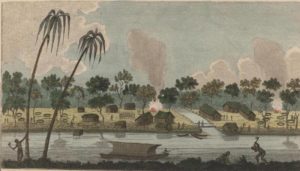How did Natural History Affect Colonization?

Image from John Gabriel Stedman, View of the Camp at the Java Creek, Narrative, of a five years' expedition, against the revolted Negroes of Surinam, 1796.
Despite the way in which many of these images present themselves as scientific and authoritative, it is worth noting that capitalist and military aims shape the vision of these authors. In Commercial Visions: Science, Trade, and Visual Culture in the Dutch Golden Age, historian Dániel Margócsy explores how viewers engaged with images of scientific material, and how these images aimed to transform the Caribbean into a world made up of commodities available for European consumption. In short, a commercial ambition fundamentally shaped the representation of the natural world in the Caribbean (Margócsy 2014). For instance, the Royal Swedish Academy funded the trip of Peter Kalm, author of Travels into North America, in an attempt to evaluate what the new world had to offer Sweden commercially (“American Journeys Background on Travels into North America”). We also have Richard Ligon’s True and Exact History of the island of Barbadoes from 1657, which acts more as a manual for how to produce, and profit from, sugarcane plantations on the island, rather than as a record of the island’s natural history.
Many of the texts and images featured in this exhibit originate in the late 18th century, following the “Scientific Revolution” in Europe and leading into the period of Romanticism. We see in these images both the aim to produce scientific knowledge, as well as the romantic lens of the “Caribbean picturesque,” as described by historian Krista A. Thompson (Thompson 2006). Given rapidly increasing curiosity about the new world in Europe, as well as public interest in scientific and romantic ideas, many of these texts went into wide circulation and influenced how people viewed the Caribbean. At the same time, engraving tools became more widely available, and printers included increasingly detailed images of natural history. These new detailed images suggested the further accuracy of scientific knowledge; however, even if the engravings featured a more literal likeness to the objects at hand, their accuracy is debatable—they were not drawn in the service of truth, but were rather designed to appeal to a European audience.
As visual sociologist Luc Pauwels, editor and co-author of Visual Cultures of Science: Rethinking Representational Practices in Knowledge Building and Science Communication, claims, “There is no state where things are perceived in an uncolored and unbiased form.” He argues that “visualization of science” is constructed to aid the progression of science and culture, rather than produce true and objective information (Pauwels 2005 viii). Although many of the images were literally presented as being “true” and “exact,” contemporary research suggests otherwise. In their drawings, paintings, and engravings, European colonizers put forth a claim for the islands (and their resources) while also framing their natural histories as newly discovered, and presented the information as wholly original knowledge–making an intellectual claim for the flora and fauna of the lands, which had been known to the indigenous people for generations. Although image-making may lack the material weight of military or legal claims to land and people, it has similar substantive effects. The ideal of omniscient scientific knowledge—one often implicitly advanced in the angle of vision of these images—is not only impossible but is itself a technology of empire, one aimed at acquisition. The "scientific knowledge" at stake in these images is thus deeply shaped by European culture and imperial aims.
One of the missions of the Early Caribbean Digital Archive is to call attention to how these texts constructed this information. The ECDA’s work is a part of the larger discussion on how students, academics, and other thinkers can reevaluate how they use and understand archival materials and how they can better use them their own work. In this exhibit, we highlight several items from our archive and think of ways to ‘remix’ the information that it provides. We invite you to take different angles of vision on these images than those that their earliest authors may have intended.
